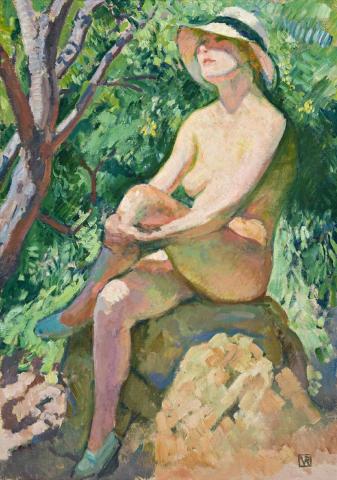NUDE WITH CROSSED LEGS IN A PANAMA HAT
THÉO VAN RYSSELBERGHE
oil on canvas
65.0 x 48.0 cm
signed lower right with artist's monogram: VR
inscribed on artist's label verso: Sud St Clair / Nu au panama croisant les jambs
Gallerie Nicoline Pon, Zurich, 1976
Private collection, Frankfurt
Thence by descent
Private collection, Melbourne
Deutscher and Hackett, Melbourne, 26 August 2009, lot 29
Private collection, Sydney
Théo van Rysselberghe, along with contemporaries Georges Seurat, Camille Pissarro and Paul Signac, was one of the key Neo-Impressionist painters of northern Europe. Also known as Divisionism and Pointillism, Neo-Impressionism was one of the most innovative and startling of the late 19th century avant-garde styles. Characterised by a refinement of the impulsive and intuitive artistic mannerism of Impressionism, the style was underpinned by a rigorous attention to the scientific principles of colour theory. The Neo-Impressionists '...came to believe that separate touches of interwoven pigment result in a greater vibrancy of color in the observer's eye than is achieved by the conventional mixing of pigments on the palette. Known as melange optique (optical mixture), this meticulous paint application would, they felt, realize a pulsating shimmer of light on the canvas.'1
Introduced to Seurat when only 24, van Rysselberghe was responsible for the 'importation' of the style to his native Belgium. Already a prominent figure there, he had co-founded the radical artistic circle Les XX in 1883 which had brought him into contact with James Ensor, Henri de Toulouse-Lautrec and Auguste Rodin. Of the group, it was most certainly James Abbott McNeill Whistler, who exhibited with Les XX in 1884, whose influence as a portrait painter can be most observed. It is the fusion of Neo-Impressionism with portraiture that was to establish van Rysselberghe as a remarkable artist, producing such masterpieces as Portrait d'Octave Maus, 1885 (Royal Museums of Fine Arts of Belgium, Brussels).
With his early attraction to the exotic, van Rysselberghe travelled extensively throughout his life. He spent considerable time in Morocco and Spain, resulting in an obsession with light which is captured in his Fantasia Arabe (Arab Fantasia), 1884 (Royal Museums of Fine Arts of Belgium, Brussels). With a theme introduced by Eugene Delacroix, the painting is bathed in the harsh light of the hot Moroccan sun and was exhibited as part of the 2006 Retrospective exhibition, Théo van Rysselberghe at the Palais des Beaux-Arts in Brussels and the Gemeentemuseum in The Hague, Netherlands.
It is here, in this gentle rendering of the nude, that we can best observe the delicate touch, refined chromatic sense and luminosity that established van Rysselberghe as one of the finest Flemish artists of his period. Camille Mauclair confirmed his position as an artist who ought to be '... considered as the most significant of the Neo-Impressionists. It is really in him that one has to see the young and worthy heir of Monet, of Sisley, and of Degas...'2
1. Amory, D., 'Georges Seurat and Neo-Impressionism', Heilbrunn Timeline of Art History, The Metropolitan Museum of Art, New York, 2004
2. Mauclair, C., The French Impressionists (1860-1900), Duckworth and Co., London, 1903, p. 127
